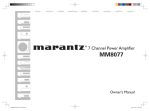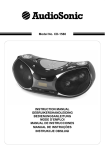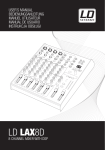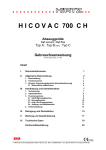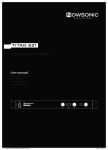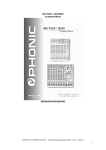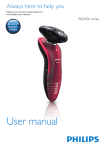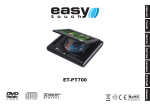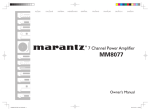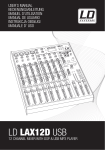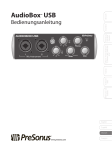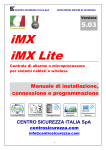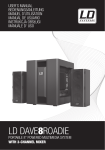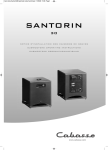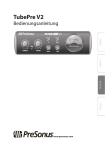Download Active Mini-Reference Monitors User manual
Transcript
RADIOCHECK User manual www.nowsonic.com GB Active Mini-Reference Monitors User manual Bedienungsanleitung Mode d‘emploi Manual del usuario Podręcznik użytkownika C Radiocheck_Manual_PRINT_15_01_14.indd 3 15.01.14 10:33 User manual 4 Bedienungsanleitung8 Mode d‘emploi 12 Manual del usuario 16 Podręcznik użytkownika 20 Radiocheck_Manual_PRINT_15_01_14.indd 3 15.01.14 10:33 GB RADIOCHECK User manual www.nowsonic.com IMPORTANT SAFETY INSTRUCTIONS WARNiNG: To reduce the risk of fire or electric shock, do not expose this apparatus to rain or moisture. Do not expose this equipment to dripping or splashing and ensure that no objects filled with liquids, such as vases, are placed on the equipment. This apparatus must be earthed. Use a three-wire grounding type line cord like the one supplied with the product. Be advised that different operating voltages require the use of different types of line cord and attachment plugs. Always observe the local safety regulations. Ensure that the factoryset power requirements for the device (refer to the label on the rear panel) corresponds to the mains supply in your region. This equipment should be installed near the socket outlet and disconnection of the device should be easily accessible. To completely disconnect this equipment from the AC Mains, disconnect the power supply cord plug from the AC receptacle. Please follow all instructions of the manufacturer for installation. Do not install in a confined space. Do not open the unit - risk of electric shock. 1) Read these instructions. 2) Keep these instructions. 3) Heed all warnings. 4) Follow all instructions. 5) Do not use this apparatus near water. 6) Clean only with dry cloth. 7) Do not block any of the ventilation openings! Install in accordance with the manufacturer’s instructions. 8) Do not install near any heat sources such as radiators, heat registers, stoves, or other apparatus (including amplifiers) that produce heat. 9) Do not defeat the safety purpose of the polarized or groundingtype plug. A polarized plug has two blades with one wider than the other. A grounding type plug has two blades and a third grounding prong. The wide blade or the third prong is provided for your safety. If the provided plug does not fit into your outlet, consult an electrician for replacement of the obsolete outlet. 10)Protect the power cord from being walked on or pinched, particularly at plugs, convenience receptacles, and the point where they exit from the apparatus. 11)Only use attachments/accessories specified by the manufacturer. 12) Use only with a cart, stand, tripod, bracket, or table specified by the manufacturer, or sold with the apparatus. When a cart is used, use caution when moving the cart/apparatus combination to avoid injury from tip-over. 13)Unplug this apparatus during lightning storms or when unused for long periods of time. 14)Refer all servicing to qualified service personnel. Servicing is required when the apparatus has been damaged in any way, such as power-supply cord or plug is damaged, liquid has been spilled or objects have fallen into the apparatus, the apparatus has been exposed to rain or moisture, does not operate normally, or has been dropped. CAUTION! Please note: Changes or modifications to the device not expressly approved in this manual could void your authority to operate the instrument. Servicing There are no user-serviceable parts inside. All service must be performed by qualified personnel. CAUTION: TO REDUCE THE RISK OF ELECTRIC SHOCK, DO NOT REMOVE THE COVER. NO USER SERVICEABLE PARTS INSIDE. REFER SERVICING TO QUALIFIED PERSONNEL ONLY. Warning: To reduce the risk of fire or electric shock, do not expose the device to rain or moisture. The lightning flash with an arrowhead symbol within an equilateral triangle is intended to alert the user to the presence of uninsulated “dangerous voltage” within the product’s enclosure that may be of sufficient magnitude to constitute a risk of electric shock to persons. The exclamation point within an equilateral triangle is intended to alert the user to the presence of important operating and maintenance(servicing) instructions in the literature accompanying the product. 4 Radiocheck_Manual_PRINT_15_01_14.indd 4 15.01.14 10:33 RADIOCHECK User manual www.nowsonic.com GB Content Important safety instructions Introduction Development objective Cabinet design Connectors and controls on the rear panel Placement Connecting and setting the monitor level RadioCheck „Break-In” suggestion Specifications Scope of supply Disclaimer Servicing Legal information Introduction Thank you very much for purchasing the active near-field monitor Nowsonic RadioCheck. This monitor was designed as a self-powered high resolution, full-range mini-reference monitors for fixed or remote application. In addition, Nowsonic RadioCheck features a timeless design with only one full-range speaker and therefore is an interesting alternative or complement for monitoring with typical multi-way systems. Cabinet design The cabinet enclosure is constructed with non-layered and high-tensile MDF panels and therefore has a natural low-resonance characteristic. All cabinet edges are radiused. The speaker has a very elegant design with a „butter cream“ high gloss finish from Polyurethane. On the bottom of the enclosure, a 7mm thick neoprene pad has been embedded as a skid-resistant acoustic isolator. For flexible mounting of RadioCheck the bottom plate also features an industry standard 5/8”-27 mic stand mount. Development objective Nowadays, most recording studios are equipped with powerful 2 or 3 way systems that allow for monitoring your mixes at high listening levels. However – in the age of high definition audio, it is also important to check your mixes on a compact audio system without the enhanced low end of a multi-way system. In fact it might be more useful to know how your mix will sound via the loudspeaker of a TV or clock radio, the car hifi or via the docking station of an iPod. It is definitely important to make mixing judgments based partially on listening to reference monitors that will not impart tonal anomalies caused by crossovers or inferior full range drivers. Particular attention is always paid to the critical mid-range with the fundamentals of the vocals, guitars and keyboard parts. This is where having a full-range monitor without a crossover is truly revealing. That is why our R&D department has spent more than twelve months of intense research with comparative listening and tweaking on the voicing of the Nowsonic RadioCheck. The result is a very smooth sounding and technically updated full-range version of the 5C Sound Cubes mixing engineers were so fond of in the 1980‘s and 1990‘s. Listening tests have shown that the Nowsonic RadioCheck has a smoother midrange as well as a more accurate and transparent top end response with extended bass while maintaining the basic characteristics of those legendary speakers. 5 Radiocheck_Manual_PRINT_15_01_14.indd 5 15.01.14 10:33 GB RADIOCHECK User manual www.nowsonic.com Connectors and controls on the rear panel Balanced input This balanced Combo socket serves for connecting balanced sources with male XLR or 1/4“ TRS jacks. Alternatively, an unbalanced male TS jack can be inserted to the socket. For unbalanced operation with a TS connector the minus signal is automatically grounded. Placement The Nowsonic RadioCheck can be installed on appropriate stands or on the bridge of your mixing desk. When positioning the monitors it is best to keep them at ear level and slightly angled in towards your listening position. The optimum stereo listening perspective is achieved by forming an equilateral triangle with an equal distance from each monitor to the other and to your ears (the distance between the monitors and your ears should be quite the same). Ground Lift switch This switch decouples the earth conductor of the speaker electronics from the audio connectors ground. This is especially useful if any ground loops occur due to a doubled grounding via the power supply. Switch it to left means the unit is not earthed, while turn it to right means that the unit is earthed now. Connecting and setting the monitor level Before plugging in and powering up your RadioCheck speakers please take a moment and make sure that the power supplies are properly set according to your local mains voltage. Connect your source (mixing desk, monitoring controller etc.) to the balanced inputs on the rear of the speakers using appropriate cables. Set all faders and level controls on your source to minimum. Power up all other equipment first and then your RadioCheck monitors: This ensures that the speaker will not be damaged by any switch-on pulse. The volume control on the rear of your RadioCheck monitors is set at minimum at the factory so as to avoid an accidental overload upon initial hookup. This is intended to force the engineer to accurately adapt the rear panel gain controls to the output level of the source and to the desired listening level. When powering down your system, turn off the RadioCheck first and then all other source devices, This ensures that the speaker will not be damaged by any turn off spikes. System Gain control With this knob you can adjust the playback volume for every RadioCheck monitor separately between -30 and +6dB. For stereo use please make sure that the volume controls on both speakers are equally balanced. Otherwise the acoustic balance between both speakers and therefore the stereo image could be damaged. Power switch This switch turns the internal power amplifier in RadioCheck on and off. Please note that the speaker is still connected to the external DC adapter and hence with the mains supply even when the switch is in the Off position. DC in jack The supplied mains adapter is plugged to this socket. Tighten the lock screw of the cable/connector securely for reliable operation. NOTE At the factory the power supply adapter has been pre-set to the mains voltage in your country. For use abroad you can set another voltage via the switch on the external power supply adapter. 6 Radiocheck_Manual_PRINT_15_01_14.indd 6 15.01.14 10:33 RADIOCHECK User manual www.nowsonic.com RadioCheck „Break-In” suggestion By default, all full range speakers are a little bit „tight“. So it‘s recommended to „break-in“ the speakers for a certain time before critically monitoring any mixes. Normally, standard usage of the speakers over a short period of time is all that is required before you recognize the tonal changes taking place with the driver “flexing” from some hours of use. However, if you need to “get to work” immediately, then we do have a suggested “break-in” mode that will shorten the natural process. Though the Nowsonic RadioCheck do perform solidly right out of the box it is beneficial to actually run them through a “burn-in” period before using them in professional mix situations. Some manufacturers of high-end speakers claim that their speakers need a 100-200 hour break-in period before they are “normalized” – which in fact is just the time that most professional engineers need to get used to their new monitors. We state that simply playing any commercial music CD with good low frequency content through the monitors on a loop for 24-72 hours at a medium volume level can easily do this. This procedure serves to “normalize” the driver surrounds by flexing them. Users have reported that this speeds up the break-in process and the RadioCheck monitors seem to “open-up” a bit more than when first powered up. Whatever process you utilize, you can be sure that you have purchased an amazing tool that will help you in determining and balancing the proper levels and tones of your allimportant mixes! This “Break-In” suggestion shall remind you that like all things new, (i.e. a new car), a short break-in time is a good time for the user to flex, normalize and get used to his new equipment. You can then use your new product with delight! Spezifikationen Design: Frequency response: Max. SPL: Power: SN ratio: Cooling: Speaker: Cabinet: Inputs: Dimensions: Weight: GB Disclaimer Nowsonic has taken all possible steps to ensure that the information given here is both correct and complete. In no event can Nowsonic accept any liability or responsibility for any loss or damage to the owner of the equipment, any third party, or any equipment which may result from use of this manual or the equipment which it describes. Servicing If you have any question or encounter technical issues, please first contact your local dealer from whom you have purchased the device. In case servicing is required, please contact your local dealer. Otherwise you may contact us directly. Please find our contact data on our website under www.nowsonic.com. NOTE We take great care in packing the device in a well protected box at the factory, so any shipping damage is very unlikely. However, should this happen please contact your supplier immediately to report the damage. We recommend to keep the original packing materials in case you need to ship or transport the device at a later date. IMPORTANT! Be sure to select the proper operating voltage on the power supply/ transformer before plugging in the transformer to the AC power source. Improper selection can result in damage to the unit that will not be covered under the warranty. Legal information Active shielded full range speaker with Copyright for this user manual © 2013: Nowsonic internal power amplifier Product features, specifications and availability are subject to change 90 Hz – 17 kHz (audible range) without prior notice. 101 dB / 1m @ 1% THD (Rosa Rauschen) Edition v1.0, 07/2013 76 Watt RMS Class A/B 105dB, A weighted Convection / Heat sink-aluminum fins 8 ohm, 5,25“ die cast aluminum frame with paper cone Shielded enclosure, 18mm MDF with Dacron acoustical stuffing Combo input, XLR and 1/4“ TRS jack, + 4dBu, balanced and unbalanced connection cabinet without heat sink 165 x 165 x 206mm (H x W x D) cabinet with heat sink 165 x 165 x 241 mm (H x W x D) 3,55 kg Scope of supply RadioCheck: 1 pc Power supply: 1 pc Power cord: 1 pc 7 Radiocheck_Manual_PRINT_15_01_14.indd 7 15.01.14 10:33 D RADIOCHECK Bedienungsanleitung www.nowsonic.com WICHTIGE SICHERHEITSHINWEISE! WARNUNG: Verringern Sie die Gefahr von Feuer und elektrischen Stromschlägen, indem Sie das Gerät nicht Regen oder Feuchtigkeit aussetzen. Stellen Sie keine Behälter mit Flüssigkeiten auf das Gerät, da diese umkippen könnten und Wasser in das Gerät gelangen könnte. Dieses Gerät muss geerdet sein. Verwenden Sie ein geschirmtes Netzkabel mit drei Leitern wie das mit dem Gerät ausgelieferte Netzkabel. Beachten Sie, dass bei unterschiedlichen Betriebsspannungen unterschiedliche Netzkabel und/oder Netzstecker benötigt werden. Beachten Sie zu jeder Zeit Ihre lokalen Sicherheitsvorschriften. Stellen Sie sicher, dass die für die Monitore ab Werk eingestellte Werte (siehe Aufkleber auf der Rückseite) mit Ihrer lokalen Netzspannung überein stimmen. Stellen Sie das Gerät in der Nähe einer Netzsteckdose auf. Die Steckdose sollte immer leicht zugänglich sein. Um das Gerät völlig stromlos zu machen, ziehen Sie den Netzstecker aus der Steckdose. Befolgen Sie bei der Aufstellung immer alle Hinweise des Herstellers. Betreiben Sie das Gerät nicht unter beengten Platzverhältnissen. Öffnen Sie das Gerät nicht – Gefahr eines Stromschlags. VORSICHT! Beachten Sie, dass alle Änderungen oder Modifikationen am Gerät, die nicht ausdrücklich in diesem Handbuch eingeräumt werden, Ihre Berechtigung zum Betrieb dieses Gerät aufheben können Wartung Es befinden sich keine vom Anwender zu wartenden Teile im Gerät. Lassen Sie das Gerät nur von qualifiziertem Fachpersonal reparieren. 1) Lesen Sie diese Anleitung. 2) Bewahren Sie diese Anleitung auf. 3) Beachten Sie alle Warnungen. 4) Befolgen Sie alle Anweisungen. 5) Betreiben Sie dieses Gerät nicht in unmittelbarer Nähe von Wasser. 6) Verwenden Sie zum Reinigen des Geräts ausschließlich ein trockenes Tuch. 7) Halten Sie die Lüftungsschlitze frei! Folgen Sie bei der Installation den Anweisungen des Herstellers. 8) Stellen Sie das Gerät nicht in der Nähe von Heizkörpern, Wärmespeichern, Öfen oder anderer Wärmequellen auf. 9) Kleben Sie in keinem Fall den Schutzkontakt des Steckers ab. Ein verpolungssicherer Stecker besitzt zwei Kontakte, von denen ein Kontakt breiter ist als der andere. Ein Schukostecker besitzt zwei Kontakte und einen dritten Erdungskontakt. Der breitere Kontakt des verpolungssicheren Steckers bzw. der Erdungskontakt des Schukosteckers dient Ihrer Sicherheit. Sollte der Stecker des mitgelieferten Netzkabels nicht in Ihre Steckdose passen, besorgen Sie sich im Fachhandel ein passendes Kabel. 10) Treten Sie nicht auf das Kabel, knicken Sie das Kabel nicht und behandeln Sie Stecker und Buchsen besonders vorsichtig. 11) Verwenden Sie ausschließlich Zubehör, das vom Hersteller für das Gerät vorgesehen ist. 12) Verwenden Sie nur Ständer, Stative oder Tische, die den Anforderungen des Herstellers entsprechen oder die zum Lieferumfang des Geräts gehören. Seien Sie beim Transport vorsichtig, um Verletzungen durch verrutschende oder fallende Gegenstände zu vermeiden. 13) Ziehen Sie während eines Gewitters den Netzstecker; ziehen Sie den Netzstecker auch, wenn Sie das Gerät längere Zeit nicht verwenden. 14) Wenden Sie sich im Service-Fall an qualifiziertes Personal. Lassen Sie das Gerät von einem Fachmann überprüfen, wenn z.B. Netzkabel oder -stecker beschädigt sind, wenn Flüssigkeit oder Gegenstände in das Gehäuse gelangt sind, das Gerät Regen oder Feuchtigkeit ausgesetzt war, das Gerät fallen gelassen wurde, nicht ordnungsgemäß funktioniert oder anderweitig beschädigt wurde. VORSICHT: ZUM SCHUTZ VOR STROMSCHLÄGEN DARF DAS GEHÄUSE NICHT GEÖFFNET WERDEN. ES BEFINDEN SICH KEINE VOM ANWENDER TAIUSCHBAREN BAUTEILE IM GERÄT. WENDEN SIE SICH IM SERVICEFALL AN QUALIFIZIERTES FACHPERSONAL. Warnung: Zum Schutz vor Brand oder Stromschlag darf dieses Gerät weder Regen noch Feuchtigkeit ausgesetzt sein. Das Blitzsymbol innerhalb eines gleichseitigen Dreiecks soll den Anwender auf nicht isolierte Leitungen und Kontakte im Geräteinneren hinweisen, an denen hohe Spannungen anliegen, die im Fall einer Berührung zu lebensgefährlichen Stromschlägen führen können. Das Ausrufezeichen innerhalb eines gleichseitigen Dreiecks soll den Anwender auf wichtige Bedienungs- sowie Servicehinweise in den dazugehörigen Handbüchern aufmerksam machen. 8 Radiocheck_Manual_PRINT_15_01_14.indd 8 15.01.14 10:33 RADIOCHECK Bedienungsanleitung www.nowsonic.com D Inhalt Einleitung Zielsetzung Gehäuseaufbau Rückseitige Anschlüsse und Bedienelemente Aufstellung Verkabelung und Einstellen der Abhörlautstärke Empfehlung zum „Einschwingen“ der RadioCheck-Lautsprecher Spezifikationen Lieferumfang Haftungsausschluss Service Rechtliche Hinweise Gehäuseaufbau Das Gehäuse wird aus massiven und hochstabilen MDF-Platten gefertigt und bietet materialbedingt eine extrem geringe Eigenresonanz. Alle Gehäusekanten und –ecken sind abgerundet. Das elegante Design wird durch das „creme-farbene“ Hochglanz-Finish aus Polyurethan-Lack unterstrichen. Auf der Gehäuse-Unterseite wurde ein 7 mm starkes Pad aus Neopren integriert, das als rutschfeste akustische Isolierung dient. Zugunsten einer flexiblen Montage verfügt der RadioCheck zudem über ein integriertes Schraubgewinde (5/8”-27) zur Montage auf herkömmlichen Schraubstativen. Einleitung Herzlichen Glückwunsch zum Kauf der aktiven Nahfeldmonitore Nowsonic RadioCheck. Ziel bei der Entwicklung dieser Monitore war es, extrem kompakte Aktivlautsprecher mit einer besonders hohen Auflösung für den mobilen Einsatz oder die Festinstallation anzubieten. Gleichzeitig bieten die Nowsonic RadioCheck eine zeitlose Bauform mit einem einzigen Fullrange-Lautsprecher und sind damit als Alternative oder Ergänzung für das Monitoring über Mehrweg-Systeme interessant. Zielsetzung In Tonstudios kommen heutzutage hauptsächlich leistungsfähige 2oder 3-Wege-Systeme zur Beurteilung einer Mischung bei hohen Abhörlautstärken zum Einsatz. Im Zeitalter von High-Definition-Audio ist es aber genauso wichtig, die eigene Mischung auch über kompakte Systeme ohne das erweiterte Bass-Fundament eines Mehrwegsystems abzuhören. Eventuell ist die Information sogar sehr viel wertvoller, wie sich eine Mischung über die Lautsprecher eines Fernsehers, Küchenradios, im Auto oder über die Docking-Station eines iPods anhört. In jedem Fall sollte jeder Toningenieur die Möglichkeit nutzen und seine Mischung ohne die störenden Einflüsse einer Frequenzweiche oder das Übertragungsverhalten eines minderwertigen Fullrange-Lautsprechers beurteilen. Speziell der Mittenbereich mit den harmonischen Grundanteilen von Gesang, Gitarren und Keyboards ist besonders sensibel und kann erst auf einem hochwertigen Fullrange-Lautsprecher ohne Frequenzweiche korrekt beurteilt werden. Entsprechend hat unsere Entwicklungsabteilung mehr als 12 Monate intensiver Forschung mit Hörvergleichen und spezifischer Anpassung in das Voicing des Nowsonic RadioCheck investiert. Das Ergebnis ist eine sehr angenehm klingende und technisch aktuelle Fullrange-Version der 5C Sound Cubes, die sich bei Toningenieuren in den 1980-er und 90-er Jahren großer Beliebtheit erfreuten. Hörvergleiche haben ergeben, dass die Nowsonic RadioCheck zwar dem Grund-Charakter dieser legendären Lautsprecher sehr nahe kommen, jedoch einen deutlich angenehmeren Mittenbereich sowie eine präzisere und transparentere Wiedergabe in den Höhen sowie eine kräftigere Basswiedergabe liefern. 9 Radiocheck_Manual_PRINT_15_01_14.indd 9 15.01.14 10:33 D RADIOCHECK Bedienungsanleitung www.nowsonic.com Rückseitige Anschlüsse und Bedienelemente ANMERKUNG: Ab Werk ist das externe Netzteil bereits korrekt auf die Spannungsversorgung in Ihrem Land voreingestellt. Sofern Sie Ihre Lautsprecher jedoch auch im Ausland betreiben möchten, können Sie das externe Netzteil über einen Schalter auch auf einen anderen Spannungswert einstellen. Symmetrischer Eingang: Diese symmetrische Combo-Buchse dient zum Anschluss von symmetrischen Quellen über männliche XLR- oder 6,35 mm TRS-Klinkenkabel. Alternativ kann die Buchse auch unsymmetrisch mit einem männlichen TS-Kabel belegt werden. Bei der unsymmetrischen Belegung mit einer TS-Quelle wird der Minus-Pol automatisch auf Masse geschaltet. Schalter Ground Lift: Mit diesem Schalter können Sie den Schutzleiteranschluss der aktiven Lautsprecher-Elektronik von der Masse der Audioanschlüsse trennen, sofern Brummschleifen durch eine doppelte Erdung über die Stromversorgung auftreten. In der linken Position wird die Schirmung über den Audioanschluss unterbrochen, in der rechten Stellung ist die Elektronik über den Audioanschluss mit der Masse verbunden. Regler System Gain: Mit diesem Regler steuern Sie die Wiedergabelautstärke für jeden RadioCheck-Lautsprecher einzeln im Bereich von -30 bis +6 dB. Achten Sie im Stereobetrieb darauf, dass die Lautstärkeregler an beiden Monitoren identisch eingestellt sind: Andernfalls kann die Balance zwischen beiden Lautsprechern und damit die korrekte Darstellung im Stereobild beeinträchtigt werden. Power-Schalter: Mit diesem Schalter schalten Sie den internen Leistungsverstärker in RadioCheck ein. Beachten Sie, dass der Lautsprecher auch in der Schalterstellung 0 (Aus) weiterhin mit dem externen Netzteil und damit mit dem Stromnetz verbunden ist. Netzteilbuchse: An dieser Buchse schließen Sie das im Lieferumfang befindliche externe Netzteil an. Für einen fehlerfreien Betrieb sollten Sie die Konterschraube des Netzteilsteckers an der Buchse festziehen. Aufstellung Ihre RadioCheck-Monitore können nach Bedarf auf der Ablage eines Mischpults oder auf geeigneten Stativen betrieben werden. Achten Sie bei der Aufstellung darauf, dass sich die Lautsprecher auf Höhe Ihrer Ohren befinden und zudem nach innen auf Ihre Abhörposition gedreht sind. Für eine optimale Stereobeurteilung sollten die beiden RadioCheck-Lautsprecher so aufgestellt werden, dass sich mit Ihrer Abhörposition ein gleichseitiges Dreieck ergibt (die Abstände zwischen den Lautsprechern und Ihren Ohren sollten in etwa identisch sein). Verkabelung und Einstellen der Abhörlautstärke Bevor Sie Ihre RadioCheck-Lautsprecher mit dem Stromnetz verbinden und einschalten, sollten Sie in jedem Fall sicherstellen, dass die zugehörigen Netzteile auf Ihre lokale Netzspannung eingestellt sind. Verbinden Sie nun Ihre Quelle (Mischpult, Monitor-Controller o. ä.) mit geeigneten Kabeln mit den symmetrischen Eingängen auf der Rückseite der Lautsprecher. Ziehen Sie alle Lautstärkeregler und/oder Fader an Ihrer Quelle ganz nach unten. Schalten Sie zuerst alle übrigen Geräte und zum Schluss Ihre RadioCheck-Monitore ein: So ist sichergestellt, dass der Lautsprecher nicht durch Einschaltimpulse beschädigt wird. Der Lautstärkeregler auf der Rückseite der RadioCheck-Monitore ist ab Werk auf den Minimalwert eingestellt, um eine etwaige Überlast beim erstmaligen Einschalten zu verhindern. Entsprechend muss der Toningenieur den rückseitigen Lautstärkeregler nach dem Einschalten bewusst auf den Arbeitspegel der Quelle und die gewünschte Abhörlautstärke einstellen. Wenn Sie Ihr System ausschalten, müssen Sie in jedem Fall zuerst die RadioCheck-Lautsprecher und anschließend alle übrigen Quellgeräte ausschalten. So ist sichergestellt, dass der Lautsprecher nicht durch Ausschaltimpulse beschädigt wird. 10 Radiocheck_Manual_PRINT_15_01_14.indd 10 15.01.14 10:33 RADIOCHECK Bedienungsanleitung www.nowsonic.com Lieferumfang RadioCheck: 1x Netzteil: 1x Netzkabel: 1x Empfehlung zum „Einschwingen“ der RadioCheck-Lautsprecher Alle Fullrange-Lautsprecher bieten ab Werk eine gewisse „Steifigkeit“. Es empfiehlt sich also, diese über einen gewissen Zeitraum einzuschwingen, bevor Sie eine finale Mischung kritisch auf den Lautsprechern beurteilen sollten. Normalerweise reicht es, die Lautsprecher regelmäßig über einen längeren Zeitraum zu verwenden, um eine akustische Verbesserung durch einen „flexibleren“ Treiber zu erreichen. Wenn Sie allerdings unmittelbar „an die Arbeit gehen“ möchten, möchten wir Ihnen unser Verfahren zum „Einschwingen“ des Lautsprechers empfehlen, das den natürlichen Prozess deutlich verkürzt. Obwohl Sie die Nowsonic RadioCheck-Monitore direkt nach dem Auspacken für die tägliche Arbeit nutzen können, bringt der Vorgang des „Einschwingen“ Vorteile in einer professionellen Mischsituation. Einige „High-End“-Hersteller behaupten, dass ihre Lautsprecher zwischen 100 bis 200 Stunden „eingeschwungen“ werden müssen, bevor sie „normalisiert“ sind. Häufig entspricht das aber einfach der Zeitspanne, in der sich Toningenieure auf ihre neuen Monitore einhören. Wir sind hingegen der Meinung, dass eine Schleifenwiedergabe von kommerziellen Musik-CDs mit einem durchschnittlichen Bassanteil über 24 bis 72 Stunden bei mittlerer Lautstärke auch zum Ziel führt. Während diesem Vorgang wird die Lautsprecher-Sicke „eingeschwungen“ und verliert ihre Steifigkeit. Anwender haben uns berichtet, dass sich das Einschwingen auf diese Weise problemlos beschleunigen lässt und die Höhenwiedergabe des RadioChecks etwas offener wird. Egal für welches Verfahren Sie sich entscheiden – Sie können in jedem Fall sichergehen, dass Sie sich für ein hervorragendes Werkzeug entschieden haben, mit dem Sie die Lautstärke- und Klang-Balance in Ihren Mixes perfekt beurteilen können! Diese Empfehlung zum „Einschwingen“ soll Sie lediglich daran erinnern, dass es bei allen Produkten – selbst bei einem Auto – direkt nach der Auslieferung sowohl für den Anwender wie auch für das Produkt eine Phase zur Eingewöhnung gibt. Anschließend können Sie Ihr neues Produkt vollwertig nutzen! Spezifikationen Bauform: Frequenzgang: Maximaler Schalldruckpegel: Leistung: Signalrauschabstand: Kühlung: Lautsprecher: Gehäuse: Eingänge: Abmessungen: Gewicht: D Haftungsausschluss Nowsonic hat höchstmögliche Sorgfalt darauf verwendet, alle in diesem Handbuch enthaltenen Informationen so korrekt und vollständig wie möglich wiederzugeben. Nowsonic übernimmt keinerlei Haftung oder Verantwortung für Verluste oder Schäden, die dem Eigentümer des Geräts, Dritten oder an anderen Geräten durch die Informationen in diesem Handbuch oder das darin beschriebene Gerät entstehen. Service Wenn Sie Probleme oder technische Fragen haben, wenden Sie sich bitte zuerst an Ihren lokalen Händler, bei dem Sie das Gerät gekauft haben. Bei einem Service-Fall wenden Sie sich bitte ebenfalls an Ihren lokalen Händler. Andernfalls können Sie uns auch direkt kontaktieren. Sie finden unsere Kontaktdaten auf unserer Webseite unter www.nowsonic.com. WICHTIG! Stellen Sie das Netzteil in jedem Fall auf die korrekte Netzspannung ein, bevor Sie das Netzteil mit der Wechselstromquelle verbinden. Eine ungeeignete Einstellung kann zu Schäden am Gerät führen und ist nicht durch die Garantie abgedeckt. Aktiver geschirmter Fullrange-Lautsprecher mit integriertem Leistungsverstärker 90 Hz – 17 kHz (hörbarer Übertragungsbereich) 101 dB / 1m @ 1% THD (Rosa Rauschen) 76 Watt RMS Class A/B 105 dB, A-gewichtet Konvektion, Aluminium-Kühlkörper mit Lamellen 5,25“, 8 Ohm, Korb aus Aluminiumguss mit Papier-Membran Geschirmtes Chassis aus 18 mm MDF, akustische Innendämmung aus Dacron Combo-Buchse XLR / 6,3 mm Stereoklinke, + 4dBu, symmetrische und unsymmetrische Belegung Gehäuse ohne Kühlkörper 165 x 165 x 206 mm (H x B x T) Gehäuse mit Kühlkörper 165 x 165 x 241 mm (H x B x T) 3,55 kg ANMERKUNG Das Gerät wurde ab Werk so verpackt, dass ein ausreichend hoher Schutz gegen Transportschäden besteht. Sofern es dennoch zu einem Transportschaden gekommen sein sollte, wenden Sie sich bitte unmittelbar an den Lieferanten, der das Gerät an Sie ausgeliefert hat, und zeigen Sie den Schaden an. Wir möchten Ihnen empfehlen, das originale Verpackungsmaterial für den Fall aufzubewahren, das Sie das Gerät zu einem späteren Zeitpunkt verschicken müssen. Rechtliche Hinweise Copyright für diese Bedienungsanleitung © 2013: Nowsonic Produktmerkmale, Spezifikationen und die Verfügbarkeit können ohne vorherige Ankündigung geändert werden. Ausgabe v 1.0, 07/2013 11 Radiocheck_Manual_PRINT_15_01_14.indd 11 15.01.14 10:33 FR RADIOCHECK Mode d‘emploi www.nowsonic.com DIRECTIVES DE SÉCURITÉ IMPORTANTES! AVERTISSEMENT: Réduisez le risque d‘incendie ou d‘électrocution en n‘exposant pas le produit à la pluie ni à l‘humidité. Ne placez pas d‘objet rempli de liquide sur l‘appareil, car il pourrait se renverser et le liquide pénétrer dans l‘appareil. Cet appareil doit être mis à la terre. Utilisez un câble d‘alimentation blindé à trois conducteurs comme celui fourni avec l‘appareil. Notez qu‘en fonction de la tension d‘alimentation nécessaire, les cordons et/ou fiches d‘alimentation nécessaires sont différents. Respectez toujours les réglementations de sécurité locales. Assurez-vous que les moniteurs ont été réglés en usine (voir l‘autocollant à l‘arrière) sur la tension correspondant à votre réseau électrique local. Placez l‘appareil à proximité d‘une prise de courant. La prise doit toujours être facilement accessible. Pour totalement isoler l‘appareil du secteur, débranchez le cordon d‘alimentation de la prise. Suivez toujours toutes les instructions du fabricant pour l‘installation. Ne faites pas fonctionner l‘appareil dans un espace confiné. N‘ouvrez pas l‘appareil – Risque d‘électrocution. 1) Lisez ces indications. 2) Conservez ces indications. 3) Respectez tous les avertissements. 4) Suivez toutes les instructions. 5) N‘utilisez pas cet appareil avec de l‘eau à proximité. 6) Nettoyez-le uniquement avec un chiffon sec. 7) N‘obstruez aucune ouverture de ventilation ! Installez-le conformément aux instructions du fabricant. 8) N‘installez pas l‘appareil près de radiateurs, bouches de chauffage, poêles ou autres sources de chaleur. 9) Ne neutralisez jamais la broche de terre. Une fiche polarisée possède deux broches, l‘une plus large que l‘autre. Une fiche de terre a deux broches identiques et une troisième broche pour la mise à la terre. La broche plus large de la fiche polarisée ou la troisième broche de la fiche de terre servent à votre sécurité. Si la fiche du câble d‘alimentation fourni n‘entre pas dans votre prise, procurezvous un câble approprié chez un revendeur spécialisé. 10) Évitez de marcher sur le cordon d‘alimentation et de le plier, et soyez particulièrement délicat avec les fiches et les prises. 11) N‘utilisez que des accessoires conçus pour l‘appareil par le fabricant. 12) Utilisez-le uniquement avec un support, trépied ou table répondant aux spécifications du fabricant ou fourni avec l‘appareil. Soyez prudent lors du transport pour éviter toute blessure due au glissement à ou la chute d‘objets. 13) Débranchez le cordon d‘alimentation en cas d‘orage ou de non utilisation prolongée. 14) Confiez toute réparation à des techniciens de maintenance qualifiés. Faites-le vérifier par un technicien, par exemple si le cordon ou la fiche d‘alimentation est endommagé, si du liquide a été renversé sur l‘appareil ou si des objets sont tombés dedans, si l‘appareil a été exposé à la pluie ou à l‘humidité, s‘il ne fonctionne pas normalement, ou s‘il est endommagé. ATTENTION ! Notez que tous les changements ou modifications apportés à l‘appareil qui ne sont pas expressément indiqués dans le présent mode d‘emploi peuvent annuler votre droit à utiliser cet appareil. Entretien • Aucune pièce de l‘appareil n‘est réparable par l‘utilisateur. • Confiez toute réparation à un technicien qualifié. ATTENTION : POUR ÉVITER TOUT CHOC ÉLECTRIQUE, NE PAS OUVRIR LE BOÎTIER. AUCUN COMPOSANT DE L‘APPAREIL N‘EST REMPLAÇABLE PAR L‘UTILISATEUR. CONFIEZ TOUTE RÉPARATION À DES TECHNICIENS DE MAINTENANCE QUALIFIÉS. Avertissement: pour se protéger d‘un incendie ou d‘une électrocution, cet appareil ne doit pas être exposé à la pluie ni à l‘humidité. Le symbole d‘éclair à tête de flèche dans un triangle équilatéral sert à prévenir l‘utilisateur de la présence dans l‘enceinte du produit d‘une tension dangereuse non isolée d‘une grandeur suffisante pour constituer un risque d‘électrocution pour les personnes. Le point d‘exclamation dans un triangle équilatéral sert à prévenir l‘utilisateur de la présence d‘instructions importantes de fonctionnement et de maintenance (entretien) dans les documents accompagnant l‘appareil. 12 Radiocheck_Manual_PRINT_15_01_14.indd 12 15.01.14 10:34 RADIOCHECK Mode d‘emploi www.nowsonic.com FR Mode d‘emploi Directives de sécurité importantes Introduction Objectif Construction de l‘enceinte Connexions et commandes du panneau arrière Installation Câblage et réglage du volume d‘écoute Recommandation de « rodage » de l‘enceinte RadioCheck Caractéristiques techniques Contenu Clause de non responsabilité Maintenance Mentions légales Introduction Félicitations pour votre achat du moniteur actif de proximité RadioCheck Nowsonic. L‘objectif lors du développement de ces moniteurs était d‘offrir une enceinte active extrêmement compacte avec une résolution particulièrement élevée pour une utilisation mobile ou une installation fixe. En même temps, les RadioCheck Nowsonic offrent un design intemporel avec un seul haut-parleur large bande et sont donc des alternatives ou compléments intéressants en écoute de contrôle par rapport à des systèmes à plusieurs voies. Construction de l‘enceinte L‘enceinte est en panneaux de MDF compacts et très robustes, et présente de par ce matériau une très faible auto-résonance. Tous les bords et coins de l‘enceinte sont arrondis. L‘élégant design est souligné par la finition « couleur crème » à vernis polyuréthane haute brillance. Sous l‘enceinte, un coussinet de 7 mm d‘épaisseur en néoprène sert d‘isolant acoustique antidérapant. Pour la flexibilité du montage, le RadioCheck dispose également d‘un orifice fileté (5/8 „-27) permettant de l‘installer sur un pied standard. Objectif De nos jours, dans les studios d‘enregistrement, on utilise principalement de puissants systèmes d‘écoute de contrôle du mixage à 2 ou 3 voies, à volume élevé. À l‘ère de l‘audio haute définition, il est tout aussi important de contrôler également votre mixage sur des systèmes compacts sans la descente plus profonde dans les graves d‘un système à plusieurs voies. L‘information peut être beaucoup plus utile pour savoir comme sera reproduit un mixage sur les haut-parleurs d‘un téléviseur, d‘une radio de cuisine, d‘un autoradio ou sur une station d‘accueil pour iPod. Dans tous les cas, tout ingénieur du son doit saisir la possibilité d‘évaluer son mixage sans les influences perturbatrices d‘un filtre répartiteur (crossover) ni la réponse d‘un haut-parleur large bande de faible qualité. Les médiums qui contiennent les harmoniques de base du chant, des guitares et des claviers, sont particulièrement sensibles et ne peuvent être correctement contrôlés que sur un haut-parleur large bande de haute qualité sans crossover. Par conséquent, notre département de recherche et développement a consacré plus de 12 mois de recherche intensive avec des comparaisons auditives et une adaptation spécifique de la sonorité des RadioCheck Nowsonic. Le résultat est une version large bande à la sonorité très agréable et à la technologie actuelle des cubes sonores 5C, très appréciés par les ingénieurs du son dans les années 1980 et 90. Des tests d‘écoute ont montré que les RadioCheck Nowsonic étaient très proches du caractère fondamental de ces légendaires enceintes, offrant toutefois des médiums nettement plus agréables, une reproduction précise et transparente des aigus ainsi que des basses plus fermes. 13 Radiocheck_Manual_PRINT_15_01_14.indd 13 15.01.14 10:34 FR RADIOCHECK Mode d‘emploi www.nowsonic.com Connexions et commandes du panneau arrière REMARQUE: l‘alimentation externe est déjà correctement prévue en usine pour la tension électrique en vigueur dans votre pays. Toutefois, si vous voulez utiliser vos enceintes à l‘étranger, vous pouvez régler l‘alimentation externe sur une autre valeur de tension au moyen d‘un sélecteur. Entrée symétrique Cette prise mixte symétrique permet de brancher des sources symétriques au moyen d‘un câble à fiche mâle XLR ou jack 6,35 mm 3 points (TRS). Sinon, le connecteur peut également recevoir un câble asymétrique à jack 6,35 mm mâle 2 points (TS). En cas de connexion asymétrique avec une source à 2 points (TS), le pôle négatif est automatiquement relié à la masse. Commutateur de suppression de masse Avec ce commutateur, vous pouvez séparer la masse de l‘électronique active de l‘enceinte et la masse des prises audio en cas de boucle de masse due à une double mise à la terre de l‘alimentation électrique. Avec le commutateur sur la gauche, le blindage est coupé sur la sortie audio ; sur la droite, l‘électronique est connectée à la masse par l‘intermédiaire de la prise audio. Commande de gain du système Utilisez cette commande pour régler individuellement le volume de reproduction de chaque enceinte RadioCheck de -30 à +6 dB. En mode stéréo, veillez à ce que les commandes de volume des deux moniteurs soient réglées de manière identique : sinon, la balance entre les deux enceintes, et donc la représentation correcte de l‘image stéréo peuvent être affectées. Interrupteur d‘alimentation Avec cet interrupteur, vous allumez l‘amplificateur de puissance interne du RadioCheck. Notez que même en position 0 (Off ), l‘enceinte est toujours connectée à l‘alimentation externe et donc au réseau électrique. Prise d‘alimentation électrique Branchez à cette prise l‘alimentation externe fournie. Pour un fonctionnement correct, la vis de verrouillage de la fiche d‘alimentation sur la prise doit être serrée. Installation Vos moniteurs RadioCheck peuvent être posés si besoin est sur une table de mixage ou des pieds adaptés. À l‘installation, veillez à ce que les haut-parleurs soient à la hauteur de vos oreilles et également qu‘ils soient tournés vers l‘intérieur en direction de votre position d‘écoute. Pour une évaluation optimale de la stéréo, les deux enceintes RadioCheck doivent être positionnées de façon à former un triangle équilatéral avec votre position d‘écoute (les distances entre les enceintes et vos oreilles doivent être sensiblement identiques). Câblage et réglage du volume d‘écoute Avant de raccorder vos enceintes RadioCheck au secteur et de les allumer, vous devez toujours vous assurer que les alimentations associées sont réglées sur votre tension secteur locale. Ensuite, branchez votre source (console de mixage, contrôleur de moniteurs, etc.) aux entrées symétriques à l‘arrière des enceintes avec les câbles appropriés. Baissez complètement toutes les commandes de volumes et/ou faders de votre source. Allumez d‘abord tous les autres appareils, et en dernier vos moniteurs RadioCheck : cela garantit que le haut-parleur ne soit pas endommagé par l‘impulsion de la mise sous tension. La commande de volume à l‘arrière du moniteur RadioCheck est réglée en usine sur la valeur minimale pour éviter une surcharge éventuelle la première fois que vous l‘allumez. Par conséquent, l‘ingénieur du son doit régler correctement la commande de volume à l‘arrière du moniteur après l‘allumage par rapport au niveau de fonctionnement de la source et au niveau d‘écoute désiré. Pour éteindre votre système, vous devez toujours commencer par les enceintes RadioCheck et continuer avec le reste des appareils sources. Cela garantit que le haut-parleur ne soit pas endommagé par l‘impulsion de la mise hors tension. 14 Radiocheck_Manual_PRINT_15_01_14.indd 14 15.01.14 10:34 RADIOCHECK Mode d‘emploi www.nowsonic.com Recommandation de « rodage » de l‘enceinte RadioCheck Tous les haut-parleurs large bande présentent d‘origine une certaine « rigidité ». Il est donc recommandé de les utiliser pendant un certain temps avant d‘évaluer un mixage final important au moyen des enceintes. Normalement, il suffit d‘utiliser régulièrement les enceintes pendant une période prolongée afin d‘améliorer la « flexibilité » du haut-parleur et donc le rendu acoustique. Toutefois, si vous voulez rapidement vous mettre au travail, nous vous recommandons notre méthode de « rodage » d‘enceinte, qui raccourcit considérablement le processus naturel. Bien que vous puissiez utiliser les moniteurs RadioCheck Nowsonic dès leur déballage pour un travail quotidien, le processus de « rodage » offre des avantages dans un environnement de mixage professionnel. Certains constructeurs de « haut de gamme » affirment que leurs enceintes doivent être « rodées » entre 100 et 200 heures avant d‘être « normalisées ». Cela correspond souvent simplement à la période au cours de laquelle les ingénieurs du son s‘habituent à leurs nouveaux moniteurs. Cependant, nous sommes d‘avis que la lecture en boucle de CD de musique du commerce à volume médian durant 24 à 72 heures avec un réglage moyen des basses fait aussi bien l‘affaire. Pendant ce processus, la suspension du hautparleur est « rodée » et perd sa rigidité. Des utilisateurs ont rapporté que le rodage pouvait être ainsi accéléré sans aucun problème et que la reproduction des aigus par les RadioCheck s‘en trouvait plus épanouie. Quelle que soit la méthode que vous choisissez, vous pouvez en tout cas être sûr que vous avez opté pour un excellent outil avec lequel vous pouvez parfaitement évaluer le volume et la balance des sons dans votre mixage ! Cette recommandation de « rodage » doit simplement vous rappeler que juste après la livraison, tous les produits, même une voiture, nécessitent une phase de familiarisation à la fois pour l‘utilisateur et le produit. Vous pourrez ensuite pleinement profiter de votre nouveau produit! FR Contenu RadioCheck : 1 Alimentation électrique :1 Câble d‘alimentation : 1 Clause de non responsabilité Nowsonic a veillé avec le plus grand soin à ce que toutes les informations contenues dans ce mode d‘emploi soient aussi précises et complètes que possible. Nowsonic n‘assume aucune responsabilité en cas de perte ou dommage, subi par le propriétaire de l‘appareil, par d‘autres appareils ou par des tiers, découlant des informations contenues dans ce mode d‘emploi ou du matériel décrit ici. Maintenance Si vous avez des questions ou des problèmes techniques, veuillez d‘abord contacter le revendeur chez qui vous avez acheté l‘appareil. Pour toute réparation, veuillez également contacter votre revendeur. Si cela n‘est pas possible, vous pouvez aussi nous contacter directement. Nos coordonnées se trouvent sur notre site Web www.nowsonic.com. IMPORTANT ! Avant de brancher le bloc d‘alimentation au secteur, vérifiez toujours qu‘il est réglé sur la tension correcte. Un mauvais réglage peut causer à l‘appareil des dommages qui ne sont pas couverts par la garantie. Caractéristiques techniques Enceintes actives large bande blindées Type: avec amplificateur de puissance intégré 90 Hz – 17 kHz Réponse en fréquence: (plage de fréquences audibles) Niveau maximal de 101 dB / 1m @ 1% THD (bruit rose) pression acoustique: 76 watts RMS, Classe A/B Puissance: Rapport signal/bruit: 105 dB, pondération A Convection, dissipateur thermique à Refroidissement: ailettes en aluminium Haut-parleur: 13,3 cm, 8 ohms, saladier moulé en aluminium avec membrane en papier Enceinte: Châssis blindé en MDF de 18 mm, isolation acoustique intérieure en Dacron Entrées: Connecteur mixte XLR/jack 6,35 mm stéréo, +4 dBu, configuration symétrique ou asymétrique Dimensions:Enceinte sans dissipateur thermique 165 x 165 x 206 mm (H x L x P) Enceinte avec dissipateur thermique 165 x 165 x 241 mm (H x L x P) 3,55 kg Poids: REMARQUE: l‘appareil a été emballé à l‘usine de façon à assurer un niveau de protection suffisamment élevé contre les dommages dus à l‘expédition. S‘il a néanmoins été endommagé pendant le transport, veuillez contacter directement le vendeur qui vous a livré l‘appareil et lui indiquer les dommages. Nous vous recommandons de conserver les emballages d‘origine au cas où vous auriez besoin un jour d‘expédier l‘appareil. Mentions légales Ce mode d‘emploi est sous copyright © 2013 : Nowsonic Les fonctionnalités, caractéristiques techniques et disponibilité du produit peuvent être modifiées sans préavis. Édition v1.0, 07/2013 15 Radiocheck_Manual_PRINT_15_01_14.indd 15 15.01.14 10:34 ES RADIOCHECK Instrucciones de uso www.nowsonic.com INSTRUCCIONES DE SEGURIDAD IMPORTANTES! ADVERTENCIA: Para reducir el riesgo de incendios o descargas eléctricas, no permita que este aparato quede expuesto a la lluvia o la humedad. Este equipo no debe ser expuesto a goteos o salpicaduras de líquidos. No coloque sobre el equipo objetos que contengan líquidos, como vasos o floreros. Este dispositivo debe estar conectado a tierra. Use un cable tripe con toma de tierra como el que se suministra con el producto. Tenga en cuenta que los distintos tipos de voltajes requieren el uso de distintos tipos de cables y enchufes. Respete siempre las normas de seguridad de su país o administración. Asegúrese de que los requisitos de alimentación de corriente establecidos de fábrica para el dispositivo (consulte la etiqueta del panel posterior) se corresponden con el suministro general en su región. Este equipo debería instalarse cerca de la toma de corriente y estar fácilmente accesible para su desconexión. Para desconectar completamente este equipo de la red, desconecte el enchufe del cable de alimentación de la toma AC. Por favor siga las instrucciones del fabricante para su instalación. No lo instale en un espacio restringido. No abra la unidad - riesgo de descarga eléctrica. 1) Lea estas instrucciones. 2) Conserve estas instrucciones. 3) Preste atención a todas las advertencias. 4) Siga todo lo indicado en estas instrucciones. 5) No utilice este aparato cerca del agua. 6) Límpielo solo con un trapo suave y seco. 7) No bloquee ninguna de las aberturas de ventilación! Instale este aparato de acuerdo con las instrucciones del fabricante. 8) No instale esta unidad cerca de fuentes de calor como radiadores, calentadores, hornos u otros aparatos (incluyendo amplificadores) que produzcan calor. 9) No anule el sistema de seguridad que supone un enchufe polarizado o uno con toma de tierra. Un enchufe polarizado tiene dos bornes de distinta anchura. Uno con toma de tierra tiene dos bornes idénticos y una lámina lateral que es la conexión a tierra. Esta tercera lámina o el borne ancho se incluyen para su seguridad. Si el enchufe suministrado no encaja en su toma corriente, consulte a un electricista para sustituir la toma obsoleta. 10)Evite que el cable de corriente pueda quedar aplastado, retorcido o ser pisado, especialmente en los enchufes, receptáculos y en el punto en el que sale del aparato. 11) Use sólo acoplamientos/accesorios especifi cados por el fabricante. 12) Utilice esta unidad solo con un bastidor, soporte, trípode, mesa o base especificado por el fabricante o que se venda junto con el propio aparato. Desenchufe este aparato de la salida de corriente durante las tormentas eléctricas o si no lo va a usar durante un periodo de tiempo largo. 13)Desenchufe este aparato durante las tormentas eléctricas o cuando no lo use por un largo periodo de tiempo. 14)Remita todo servicio a personal técnico cualificado. Es necesario reparar el aparato cuando haya sufrido algún tipo de daño, como cuando se haya dañado el enchufe o cable de alimentación, se haya derramado líquido o se hayan introducido objetos en el aparato, el aparato haya sido expuesto a lluvia o humedad, no funcione de manera normal o se le haya caído. PRECAUCIÓN! Por favor tenga en cuenta que: Los cambios o modificaciones sobre este dispositivo que no hayan sido aprobadas expresamente en este manual podrían invalidar su autorización para manejar el instrumento. Servicio No hay piezas reparables-por el usuario en su interior. Para mantenimiento solicite la ayuda de personal cualificado. PRECAUCIÓN: PARA REDUCIR EL RIESGO DE DESCARGAS ELÉCTRICAS, NO DESMONTE LA CUBIERTA SUPERIOR. NO HAY PIEZAS REPARABLES POR EL USUARIO EN SU INTERIOR. REMITA TODO SERVICIO SÓLO A PERSONAL TÉCNICO CUALIFICADO Advertencia: Para reducir el riesgo de incendios o descargas eléctricas, no permita que este aparato quede expuesto a la lluvia o la humedad. El símbolo de un rayo con una punta de flecha dentro de un triángulo equilátero es para alertar al usuario de la presencia de “voltaje peligroso” sin aislar dentro del chasis del producto que puede tener la suficiente magnitud como para considerarse un riesgo de descarga eléctrica para las personas. El signo de exclamación dentro de un triángulo equilátero es para avisar al usuario de la presencia de importantes instrucciones de manejo y mantenimiento (servicio) en la documentación que acompaña al producto. 16 Radiocheck_Manual_PRINT_15_01_14.indd 16 15.01.14 10:34 RADIOCHECK Instrucciones de uso www.nowsonic.com FR Contenido Instrucciones de seguridad importantes Introducción Finalidad del desarrollo Diseño de la caja Conectores y controles del panel posterior Colocación Conexión y ajuste del nivel de monitorización Sugerencia de „Break-In” en RadioCheck Especificaciones Volumen de suministro Descargo de responsabilidad Servicio Advertencias legales Diseño de la caja El chasis de la caja está construido con paneles MDF de alta elasticidad no dispuestos en capas con lo que tiene una característica natural de baja resonancia. Todos los bordes de la caja tienen forma curva. El altavoz tiene un diseño muy elegante con un acabado esmaltado de Poliuretano. En la parte inferior del chasis, se le ha incrustado una almohadilla de neopreno de 7mm de espesor como aislante acústico y antideslizante. Para un montaje flexible de RadioCheck la base también dispone de un conector estándar de 5/8”-27 para pie de micro. Introducción ¡Muchas gracias por adquirir el monitor activo de campo cercano Nowsonic! Este monitor se diseñó como un monitor mini-referencia de rango completo, alta resolución y autoalimentado para su manejo tanto fijo como a distancia. Además, Nowsonic RadioCheck ofrece un diseño atemporal con sólo un altavoz de rango completo convirtiéndose así en una interesante alternativa o complemento para monitorización junto con los típicos sistemas de múltiples vías. Finalidad del desarrollo Hoy en día, la mayoría de los estudios de grabación están equipados con potentes sistemas de 2 ó 3 vías que permiten monitorizar las mezclas a niveles de escucha elevados. Sin embargo – en la era del audio de alta definición, también es importante probar sus mezclas en un sistema de audio compacto sin los graves mejorados de un sistema de múltiples vías. De hecho puede que fuera más útil saber cómo sonará su mezcla a través de un altavoz de un televisor o radio-alarma, el equipo hifi de su coche o la estación de conexión de un iPod. Sin duda es importante realizar juicios de valor sobre mezclas basándose en parte en escuchas con monitores de referencia que no impartan anomalias tonales causadas por crossovers o controladores de rango completo inferiores. Siempre se presta una particular atención al crítico rango de medios con los fundamentales de las partes de voces, guitarras y teclados. Aquí es donde se muestra la verdadera importancia de tener un monitor de rango completo sin un crossover. Por esta razón nuestro departamento de I&D ha dedicado más de 12 meses de intensa investigación con escuchas comparadas y ajustes sobre el sonido de Nowsonic RadioCheck. El resultado es una versión de sonido suave y tecnológicamente actualizada de rango completo de los 5C Sound Cubes que tanto gustaba a los ingenieros de mezclas de los años 80 y 90. Las pruebas de escucha han demostrado que el Nowsonic RadioCheck tiene un más suave rango de medios así como una respuesta más precisa y transparente en el extremo de agudos con amplios graves manteniendo a la vez las características básicas de esos legendarios altavoces. 17 Radiocheck_Manual_PRINT_15_01_14.indd 17 15.01.14 10:34 ES RADIOCHECK Instrucciones de uso www.nowsonic.com Conectores y controles del panel posterior OBSERVACIÓN: El adaptador de corriente ha sido preconfigura do en fábrica para la red eléctrica de su país. Para uso en el extranjero puede ajustar otro voltaje mediante el interruptor que lleva el adaptador de corriente externo. Entrada balanceada Esta toma Combo balanceada sirve para conectar fuentes balanceadas con jacks macho XLR ó TRS de 1/4“. Opcionalmente, también es posible conectar un jack TS macho no balanceado a dicha toma. Para un funcionamiento no balanceado con un conector TS la señal negativa va automáticamente a tierra. El interruptor Ground Lift Este interruptor desconecta el conductor a tierra de la electrónica del altavoz de la toma de tierra de los conectores de audio. Esto es especialmente útil si aparecen bucles de toma de tierra causados por una doble toma de tierra a través de la alimentación de corriente. Si está colocado hacia la izquierda significa que la unidad no está conectada a tierra, mientras que si se cambia a la derecha quiere decir que la unidad está conectada a tierra. El Control System Gain Con este knob es posible ajustar el volumen de reproducción para cada monitor RadioCheck por separado entre -30 y +6dB. Para un uso estéreo, por favor asegúrese de que los controles de volumen en ambos altavoces este igualmente equilibrado. De lo contrario el balance acústico entre ambos altavoces, y por tanto la imagen estéreo, podría deteriorarse. Interruptor Power Este interruptor activa y desactiva el amplificador activo interno de RadioCheck. Por favor tenga en cuenta que el altavoz está todavía conectado al adaptador de corriente DC externo y por lo tanto a la red incluso cuando el interruptor está en la posición Off. Colocación Nowsonic RadioCheck puede instalarse sobre bases apropiadas o en el puente de su mesa de mezclas. Cuando coloque los monitores es mejor mantenerlos a nivel del oído y ligeramente torcidos hacia su posición de escucha. La perspectiva de escucha estéreo óptima se consigue formando un triángulo equilátero a una distancia igual entre cada monitor y sus oídos (la distancia entre los monitores y sus oídos debería ser casi la misma). Conexión y ajuste del nivel de monitorización Antes de enchufar y encender sus altavoces RadioCheck por favor tómese un momento y asegúrese de que las tomas de corriente estén bien ajustadas según el voltaje de su red local. Conecte su fuente (mesa de mezclas, controlador de monitorización etc.) a las entradas balanceadas del panel posterior de los altavoces utilizando los cables adecuados. Ajuste todos sus faders y controles de nivel de su fuente al mínimo. Encienda primero todo el resto del equipo y después sus monitores RadioCheck: Esto le asegurará que el altavoz no sufrirá ningún daño causado por una subida repentina. El control del volumen de la parte posterior de sus monitores RadioCheck está ajustada al mínimo de fábrica para evitar una sobrecarga accidental al inicio de la conexión. Esto tiene como fin forzar al ingeniero a adaptar de forma precisa los controles de ganancia del panel posterior al nivel de salida de la fuente y al nivel de escucha deseado. Cuando apague su sistema, desactiva primero el RadioCheck y a continuación todos los dispositivos fuente. Esto asegura que el altavoz no sufrirá daños por picos inesperados durante el apagado. Toma de entrada DC El adaptador de corriente suministrado se enchufa a esta toma. Fije con fuerza el tornillo de sujección del cable/conector para un funcionamiento fiable. 18 Radiocheck_Manual_PRINT_15_01_14.indd 18 15.01.14 10:34 RADIOCHECK Instrucciones de uso www.nowsonic.com FR Volumen de suministro RadioCheck: 1 x Transformador: 1 x Cable de alimentación: 1 x Sugerencia de „Break-In” en RadioCheck Por defecto, todos los altavoces de rango completo son un poco “rígidos”. Por lo tanto es recomendable “soltar” los altavoces durante un corto espacio de tiempo antes de monitorizar en serio las mezclas. Normalmente, todo lo que se necesita es un uso estándar de los altavoces durante un corto espacio de tiempo antes de que pueda notar los cambios tonales que muestra el controlador “soltándose” tras varias horas de uso. Sin embargo, si necesita “ponerse a trabajar” de inmediato, le sugerimos un modo de procesado rápido que acortará el proceso natural. Aunque los Nowsonic RadioCheck funcionan como una roca nada más sacarlos de la caja, es aconsejable pasarlos por un periodo de “calentamiento” antes de usarlos en situaciones de mezclas profesionales. Algunos fabricantes de altavoces de alta gama indican que sus altavoces necesitan un periodo de introducción de entre 100-200 horas antes de quedar “normalizados” – que de hecho es justo el tiempo que la mayoría de ingenieros profesionales necesitan para acostumbrarse a sus nuevos monitores. Nosotros afirmamos que simplemente reproduciendo cualquier CD de música comercial con un buen contenido de bajas frecuencias a través de monitores en un loop entre 24-72 horas a un nivel de volumen medio puede fácilmente conseguir esto. Este procedimiento sirve para “normalizar” el contorno del controlador poniéndolo a prueba al máximo. Muchos usuarios han informado que esto acelera el proceso de calentamiento y que los monitores RadioCheck parecen “abrirse” un poco más que nada más encenderlos por primera vez. Sea cual sea el procedimiento que utilice, ¡puede estar seguro de que ha adquirido una asombrosa herramienta que le ayudará a determinar y equilibrar los niveles y tonalidades adecuadas de sus queridísimas y muy apreciadas mezclas! Esta sugerencia de “Break-In” le recordará que como todas las cosas nuevas, (i.e. un coche nuevo), un corto espacio de tiempo de calentamiento es bueno para que el usuario pruebe, normalice y se acostumbre a su nuevo equipo. ¡A partir de ese momento ya podrá disfrutar totalmente de su nuevo producto! Descargo de responsabilidad Nowsonic ha llevado a cabo todos los pasos posibles para asegurar que la información aquí contenida es a la vez correcta y completa. En ningún caso puede Nowsonic aceptar cualquier responsabilidad sobre cualquier pérdida o daño al propietario del equipo, terceras partes o equipos que pudieran resultar del uso de este manual o del equipo que éste describe. Servicio Si tiene problemas o preguntas técnicas, consulte primero al distribuidor local a través de quien haya adquirido el aparato. En caso de requerir servicio técnico, le rogamos que también se dirija a su distribuidor local. De lo contrario también puede ponerse directamente en contacto con nosotros. Encontrará nuestros datos de contacto en nuestra página web www.nowsonic.com. ¡IMPORTANTE! Asegúrese de seleccionar el voltaje de funcionamiento adecuado en el transformador antes de enchufar el transformador a la toma de corriente AC. Una selección inadecuada puede provocar daños a la unidad que no se verán cubiertos por la garantía. OBSERVACIÓN: Tenemos gran cuidado en el empaquetado del dispositivo colocándolo en una caja bien protegida aquí en la fábrica, por lo que es muy improbable que sufra daños durante el envío. No obstante, si esto sucediera, por favor, póngase en contacto con su vendedor inmediatamente para informar del daño. Le recomendamos que guarde los materiales que vienen en el emEspecificaciones balaje original en caso de que sea necesario enviar o transportar el Diseño: Altavoz blindado de rango completo con dispositivo en una fecha posterior. amplificador activo interno Respuesta de frecuencia: 90 Hz – 17 kHz (gama audible) Nivel de presión acústica Advertencias legales 101 dB a 1 m @ 1% T.H.D (ruido rosa) límite: Copyright de este manual del usuario © 2013: Nowsonic Potencia: 76 W RMS Class A/B Las características, especificaciones y disponibilidad del producto Relación señal/ruido: 105 dB, ponderado A pueden modificarse sin aviso previo. Refrigeración: Convección / Calor aletas de aluminio Edición v1.0, 07/2013 Altavoz: 8 ohm, marco de aluminio vaciado de 5,25“ con cono de papel Chasis: Cerramiento blindado, MDF de 18mm con relleno acústico Dacron Entradas: Entrada Combo, jack XLR y TRS de 1/4“, + 4dBu, con conexiones balanceada y no balanceada Dimensiones: chasis sin estructura de refrigeración (165 x 165 x 206mm (H x W x D) chasis con estructura de refrigeración (165 x 165 x 241 mm (H x W x D) Peso: 3.55 kg 19 Radiocheck_Manual_PRINT_15_01_14.indd 19 15.01.14 10:34 PL RADIOCHECK Instrukcja obsługi www.nowsonic.com WAŻNE WSKAZÓWKI DOTYCZĄCE BEZPIECZEŃSTWA OSTRZEŻENIE: Aby ograniczyć niebezpieczeństwo pożaru i porażenia prądem, nie wystawiaj urządzenia na deszcz i nie poddawaj go działaniu wilgoci. Nie stawiaj na urządzeniu żadnych pojemników z wodą, gdyż mogą one się przewrócić i woda może dostać się do wnętrza urządzenia. Niniejsze urządzenie musi być uziemione. Używaj trójprzewodowego, ekranowanego kabla zasilającego takiego, jak dostarczony razem z urządzeniem kabel zasilający. Zwróć uwagę, że dla różnych napięć potrzebne są różne kable zasilające i/lub wtyczki sieciowe. Przestrzegaj zawsze lokalnych przepisów bezpieczeństwa. Upewnij się, że fabrycznie ustawione wartości zasilania (zob. naklejka na płycie tylnej) zgadzają się z napięciem w Twojej lokalnej sieci. Ustaw urządzenie w pobliżu gniazda sieciowego. Gniazdo powinno być zawsze łatwo dostępne. Wyciągnij wtyczkę z gniazdka, aby całkowicie odciąć urządzenie od prądu. Podczas instalacji stosuj się do wszystkich wskazówek producenta. Nie używaj urządzenia w trudno dostępnym miejscu. Nie otwieraj urządzenia – niebezpieczeństwo porażenia prądem. 1) Przeczytaj niniejszą instrukcję. 2) Zachowaj niniejszą instrukcję. 3) Przestrzegaj wszystkich ostrzeżeń. 4) Stosuj się do wszystkich poleceń. 5) Nie obsługuj niniejszego urządzenia w pobliżu wody. 6) Do czyszczenia urządzenia używaj wyłącznie suchej ściereczki. 7) Nie zastawiaj wylotu otworów wentylacyjnych. Przy instalacji urządzenia postępuj zgodnie z poleceniami producenta. 8) Nie stawiaj urządzenia w pobliżu grzejników, bojlerów, pieców lub innych źródeł ciepła. 9) W żadnym wypadku nie zaklejaj kontaktu uziemienia wtyczki. Wtyczka bezpieczeństwa zawiera dwa bolce, z których jeden jest szerszy od drugiego. Zwykła wtyczka sieciowa zawiera dwa bolce oraz trzeci kontakt uziemienia. Szerszy bolec bezpiecznej wtyczki lub kontaktu uziemienia wtyczki sieciowej służy Twojemu bezpieczeństwu. W przypadku, kiedy wtyczka kabla sieciowego znajdującego się w dostarczonym komplecie nie pasuje do gniazdka, zakup pasujący kabel w sklepie specjalistycznym. 10)Nie depcz kabla, nie załamuj go i obchodź się z nim ostrożnie, szczególnie w miejscu połączenia z urządzeniem. 11)Używaj wyłącznie części przewidzianych przez producenta dla tego urządzenia. 12) Używaj tylko stojaków, statywów lub stołów, które odpowiadają wymaganiom producenta lub są dostarczane razem z urządzeniem. Zachowaj ostrożność podczas transportu, by uniknąć obrażeń spowodowanych przez przesuwające się lub spadające przedmioty. 13)Wyciągnij wtyczkę z gniazdka sieciowego podczas burzy a także wtedy, kiedy nie używasz urządzenia przez dłuższy czas. 14)W przypadku naprawy serwisowej korzystaj z usług wykwalifikowanego personelu. Pozwól skontrolować urządzenie fachowcowi, w przypadku kiedy np. uszkodzone są kabel lub wtyczka sieciowa, do obudowy dostały się płyny lub inne przedmioty, urządzenie stało na deszczu lub w wilgotnym środowisku, nieprawidłowo funkcjonuje lub w jakikolwiek inny sposób zostało uszkodzone. UWAGA! Zwróć uwagę, że wszystkie zmiany lub modyfikacje urządzenia, które nie są wyraźnie wymienione w niniejszej instrukcji, mogą pozbawić Cię prawa do używania tego urządzenia Konserwacja W urządzeniu nie ma żadnych części, które użytkownik musiałby poddawać konserwacji. W celu naprawy urządzenia korzystaj tylko z usług wykwalifikowanego personelu. UWAGA: ABY UNIKNĄĆ PORAŻENIA PRĄDEM, NIE WOLNO OTWIERAĆ OBUDOWY. WEWNĄTRZ URZĄDZENIA NIE MA ŻADNYCH CZĘŚCI, KTÓRE MOGĄ BYĆ WYMIENIANE PRZEZ UŻYTKOWNIKA. W przypadku naprawy serwisowej korzystaj z usług wykwalifikowanego personelu. Ostrzeżenie: dla ochrony przed pożarem lub zwarciem, nie wolno używać urządzenia w deszczu lub w wilgotnym środowisku. Symbol błyskawicy wewnątrz trójkąta równobocznego stanowi ostrzeżenie przed odsłoniętymi przewodami we wnętrzu urządzenia, znajdującymi się pod wysokim napięciem, których dotknięcie grozi niebezpiecznym dla życia porażeniem prądem. Symbol wykrzyknika wewnątrz trójkąta równoramiennego zwraca uwagę użytkownika na ważne wskazówki zawarte w załączonej instrukcji dotyczące obsługi iserwisu urządzenia. 20 Radiocheck_Manual_PRINT_15_01_14.indd 20 15.01.14 10:34 RADIOCHECK Instrukcja obsługi www.nowsonic.com PL Instrukcja obsługi Ważne wskazówki dotyczące bezpieczeństwa Wstęp Cele Konstrukcja obudowy Podłączenia i elementy obsługi na płycie tylnej Verkabelung und Einstellen der Abhörlautstärke Montaż Okablowanie i ustawienie głośności odsłuchu Zalecenia dotyczące „docierania“ głośników RadioCheck Specyfikacja Skład zestawu Wyłączenie odpowiedzialności cywilnej Serwis Zastrzeżenia prawne Konstrukcja obudowy Obudowa jest wykonana z masywnych i bardzo stabilnych płyt wiórowych MDF, które cechuje bardzo niski poziom rezonansu własnego. Wszystkie kanty i narożniki obudowy są zaokrąglone. Eleganckie wzornictwo jest podkreślone przez „kremowe“ wykończenie na wysoki połysk lakierem poliuretanowym. Na spodzie obudowy znajduje się neoprenowa mata o grubości 7 mm, która służy za antypoślizgową izolację akustyczną. Aby ułatwić montaż, RadioCheck posiada zintegrowany gwint (5/8 cala-27) do montażu na konwencjonalnych statywach z mocowaniami śrubowymi. Wstęp Serdecznie gratulujemy zakupu głośnika - monitora studyjnego Nowsonic RadioCheck. Celem opracowania niniejszego monitora było zaoferowanie maksymalnie zwartego, kompaktowego aktywnego głośnika o szczególnie wysokiej rozdzielczości dźwięku w wersji przenośnej lub do stałej instalacji. Jednocześnie Nowsonic RadioCheck oferuje ponadczasowy kształt obudowy z pojedynczym głośnikiem szerokopasmowym, stanowiący alternatywę lub uzupełnienie wielodrożnych systemów monitorowania dźwięku. Cele W studiach nagrań stosuje się obecnie głównie wydajne dwu- lub trójdrożne systemy głośnikowe do oceny miksowania przy odsłuchu dźwięku o wysokim natężeniu. W epoce dźwięku High-Definition równie ważne jest odsłuchanie efektu miksowania przez kompaktowe systemy głośnikowe z pominięciem rozbudowanych basów systemów wielodrożnych. W szczególności o wiele cenniejsza może być informacja o tym, jak brzmi zmiksowany dźwięk przez głośnik telewizora, radia kuchennego, w samochodzie lub stacji dokującej iPoda. Inżynier akustyk powinien zawsze wykorzystać możliwość oceny miksowania dźwięku bez zakłócających wpływów zwrotnicy głośnikowej lub odtwarzania głośnika szerokopasmowego gorszej jakości. W szczególności zakres średnich częstotliwości będących podstawową częścią wokalu, dźwięku gitar oraz keyboardów jest bardzo krytyczny dla brzmienia dźwięku i może być właściwie oceniony dopiero przy użyciu głośników szerokopasmowych wysokiej jakości bez zwrotnic. Nasz dział konstrukcyjny poświęcił ponad 12 miesięcy pracy na intensywne badania porównawcze słyszalności i dopasowania brzmienia urządzenia Nowsonic RadioCheck. Wynikiem tego jest bardzo przyjemnie brzmiąca i technicznie unowocześniona szerokopasmowa wersja głośników 5C Sound Cubes, które cieszyły się ogromną popularnością wśród akustyków w latach 80 i 90. Porównanie brzmienia wykazały, że jakkolwiek Nowsonic RadioCheck bliski jest charakterowi owego legendarnego głośnika, to ponadto przyjemniej brzmi w zakresie średnich częstotliwości, jak również precyzyjniej i przejrzyściej oddaje dźwięki wysokie oraz intensywniej brzmiące basy. 21 Radiocheck_Manual_PRINT_15_01_14.indd 21 15.01.14 10:34 PL RADIOCHECK Instrukcja obsługi www.nowsonic.com Podłączenia i elementy obsługi na płycie tylnej WYJAŚNIENIE: Zewnętrzny zasilacz jest fabrycznie ustawiony stosow nie do napięcia sieci w Twoim kraju. Jeśli chcesz używać głośnika za granicą, możesz zewnętrzny zasilacz przestawić przełącznikiem na odpowiednie napięcie zasilania. Wejście symetryczne To kombinowane symetryczne gniazdo służy do podłączenia źródeł symetrycznych kablami wyposażonymi we wtyki (męskie) XLR lub 6,35 mm TRS. Do wejścia może być też alternatywnie podłączony niesymetryczny sygnał kablem TS z wtykiem. Dla sygnałów TS podłączanych niesymetrycznie biegun ujemny jest automatycznie zwierany do masy. Przełącznik odcinania masy (Ground-Lift) Tym przełącznikiem możesz odłączyć sygnał uziemienia aktywnej części elektroniki głośnika od masy gniazd audio, jeśli na skutek podwójnej pętli uziemienia słyszalny staje się przydźwięk sieci. W pozycji lewej ekranowanie gniazd sygnałów audio zostaje przerwane, w pozycji prawej elektronika zostaje połączona poprzez gniazda audio z masą urządzenia. Regulator głośności Typ pokrętłem możesz w zakresie od -30 do +6 dB oddzielnie regulować głośność odtwarzania każdego głośnika RadioCheck. Zwróć uwagę na to, aby w trybie pracy stereo regulatory głośności obydwu głośników znajdowały się w takiej samej pozycji: w innym przypadku może zostać zachwiany balans między obydwoma głośnikami i przez to ulec zmianie obraz dźwięku stereofonicznego. Włącznik sieciowy Tym włącznikiem włączany zostaje wewnętrzny wzmacniacz mocy głośnika RadioCheck. Zwróć uwagę na to, że nawet w pozycji wyłączonej (0) głośnik jest nadal połączony z zasilaczem i za jego pośrednictwem z siecią.. Montaż Twoje głośniki RadioCheck mogą, w zależności od potrzeb, zostać zamontowane na półce stołu mikserskiego lub na odpowiednich statywach. Zwróć uwagę przy ustawianiu głośników, by znalazły się na wysokości Twoich uszu i były zwrócone ku sobie. W optymalnym ustawieniu do odsłuchu stereo obydwa głośniki powinny tworzyć z Twoją głową trójkąt równoramienny (odległość między głośnikami powinna być mniej więcej taka sama, jak ich odległość od Twoich uszu). Okablowanie i ustawienie głośności odsłuchu Zanim podłączysz głośniki do sieci i włączysz je do prądu, powinieneś zawsze się upewnić, że zasilacze są ustawione na właściwe napięcie zasilania. Połącz teraz źródła dźwięku (mikser, kontroler głośników monitorujących itp.) odpowiednimi kablami z symetrycznymi wejściami na płycie tylnej głośników. Przesuń regulatory głośności i/lub tłumika (fadera) do pozycji minimalnej uszkodzenia głośników przez impulsy powstałe przy włączaniu zasilania. Włącz najpierw wszystkie inne urządzenia i dopiero na końcu głośniki RadioCheck: w ten sposób unikniesz Regulator głośności na płycie tylnej głośnika RadioCheck jest fabrycznie ustawiany w pozycji minimalnej, aby uniknąć ewentualnego przeciążenia przy pierwszym jego włączeniu. Inżynier dźwięku musi w razie potrzeby dopasować pokrętłem na płycie tylnej poziom sygnału do źródła dźwięku i ustawić głośność odsłuchu. Po zakończeniu pracy należy najpierw wyłączyć głośniki RadioCheck, a następnie pozostałe urządzenia. W ten sposób unika się uszkodzenia głośników przez impulsy powstałe przy wyłączaniu zasilania. Gniazdo zasilacza Do tego gniazda należy podłączyć znajdujący się w zestawie zasilacz. Dla zapewnienia niezawodnej pracy powinieneś mocno dokręcić śrubę kontrującą wtyczki zasilacza. 22 Radiocheck_Manual_PRINT_15_01_14.indd 22 15.01.14 10:34 RADIOCHECK Instrukcja obsługi www.nowsonic.com Skład zestawu RadioCheck: 1 szt. Zasilacz: 1 szt. Kabel sieciowy: 1 szt. Zalecenia dotyczące „docierania“ głośników RadioCheck Wszystkie fabrycznie nowe głośniki szerokopasmowe charakteryzują się pewną „sztywnością“. Przez użyciem głośników do ostatecznej oceny jakości miksowania, zaleca się „docieranie“ głośników przez pewien czas. Zazwyczaj wystarczy regularnie używać głośników przez dłuższy czas, by osiągnąć ich „uelastycznienie“ i poprawę ich funkcjonowania. Jeśli jednak chcesz natychmiast przystąpić do pracy z nowymi głośnikami, proponujemy zastosowanie naszej procedury „docierania“, która znacznie skraca czas procesu „docierania“ naturalnego. Choć głośniki Nowsonic RadioCheck nadają się do użycia w codziennej pracy natychmiast po wypakowaniu, zastosowanie procedury „docierania“ przynosi korzyści w przypadku profesjonalnego miksowania dźwięku. Niektórzy producenci „High-End“ uważają, że ich głośniki wymagają 100 do 200 godzin „docierania“, zanim ich praca się nie „unormuje“. Często odpowiada do czasowi, w którym inżynierowie dźwięku przyzwyczajają się do brzmienia nowych głośników. My jesteśmy zdania, że zapętlone odtwarzanie płyt muzycznych CD z typową zawartością basów przez okres od 24 do 72 godzin przy średniej głośności prowadzi również do celu. W tym okresie resory głośnika „docierają“ się i tracą swoją sztywność. Użytkownicy informowali nas o tym, że postępując w ten sposób można bez problemu przyspieszyć „docieranie“ głośników i nieco poprawia się odtwarzanie wysokich częstotliwości. Obojętne, którą metodę wybierzesz – możesz być pewien, że zdecydowałeś się na wybór wspaniałego urządzenia, dzięki któremu będziesz mógł perfekcyjnie oceniać głośność i brzmienie miksowanego dźwięku! Niniejsze zalecenia dotyczące „docierania“ mają w gruncie rzeczy na celu przypomnienie Ci, że wszystkie produkty - nawet samochody - bezpośrednio po opuszczeniu fabryki wymagają od siebie i od użytkownika fazy wzajemnego „przyzwyczajania się“. Teraz możesz przystąpić do użytkowania w pełni sprawnego produktu! Specyfikacja Obudowa: Pasmo częstotliwości: Moc: Odstęp szumów: Chłodzenie: Głośnik: Obudowa: Wejścia: Wymiary: Waga: PL Wyłączenie odpowiedzialności cywilnej Firma Nowsonic dołożyła wszelkich starań, by wszystkie informacje w niniejszym podręczniku zostały przedstawione w jak najdokładniejszy i wyczerpujący sposób. Firma Nowsonic nie bierze na siebie jakiejkolwiek odpowiedzialności za powstałe uszkodzenia lub straty wyrządzone właścicielowi urządzenia, osobie trzeciej lub powstałe w innych urządzeniach a będących skutkiem informacji zawartych w tym podręczniku. Serwis W przypadku wystąpienia jakichkolwiek problemów lub pytań natury technicznej, prosimy zwrócić się w pierwszej kolejności do lokalnego sprzedawcy, u którego urządzenie zostało zakupione. W przypadku naprawy serwisowej, prosimy zwrócić się również do lokalnego sprzedawcy. W innym przypadku prosimy o skontaktowanie się bezpośrednio z nami. Nasze dane kontaktowe znajdziesz na naszej stronie internetowej www.nowsonic.com. WAŻNE! Koniecznie ustaw zasilacz sieciowy na właściwą wartość napięcia przed włączeniem go do sieci. Niewłaściwe ustawienie napięcia sieci może prowadzić do powstania uszkodzeń urządzenia, które nie są objęte gwarancją. WYJAŚNIENIE: urządzenie zostało firmowo tak zapakowane, by było wystarczająco zabezpieczone podczas transportu. Gdyby jednak doszło do uszkodzenia urządzenia podczas transportu, zwróć się niezwłocznie do dostawcy, który je dostarczył i wskaż uszkodzenia. Zalecamy zachowanie oryginalnego opakowania, na wypadek konieczności ponownego wysłania urządzenia. Aktywny, ekranowany głośnik szerokopasmowy z wbudowanym wzmacniaczem mocy 90 Hz – 17 kHz (zakres częstotliwości słyszalnych) 76 watów RMS, klasa A/B 105 dB, A ważony konwekcyjne, żebrowy radiator aluminiowy 5,25“, 8 Ohm, koszyk z odlewanego aluminium z membraną papierową ekranowane chassis z płyty wiórowej MDF o grubości 18 mm, wewnętrzne tłumienie akustyczne z dakronu kombinowane gniazdo XLR / 6,3 mm Jack stereo, + 4dBu, symetryczne i niesymetryczne Obudowa bez radiatora 165 x 165 x 206 mm (wysokość x szerokość x głębokość) Obudowa z radiatorem 165 x 165 x 241 mm (wysokość x szerokość x głębokość) 3,55 kg Zastrzeżenia prawne Prawa autorskie do niniejszego podręcznika użytkownika © 2013: Nowsonic Cechy produktu, specyfikacja i dostępność mogą ulec zmianie bez wcześniejszej zapowiedzi. Wydanie w. 1.0, 07/2013 23 Radiocheck_Manual_PRINT_15_01_14.indd 23 15.01.14 10:34 GB RADIOCHECK User manual www.nowsonic.com Distributed by Sound Service GmbH WEEE-Reg.-Nr.: DE 18189133 www.nowsonic.com B Radiocheck_Manual_PRINT_15_01_14.indd 2 15.01.14 10:33
























